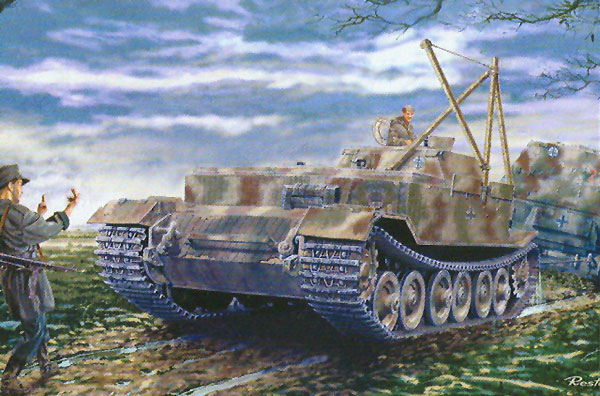|
Bergepanzer Tiger (P)

Dragon/DML, 1/35
S
u m m a r y
|
| Stock Number,
Media/Contents, Description and Price |
Dragon Models Limited 1/35 Scale
39-45 Series Kit No. 6226; Bergepanzer Tiger (P); 382 parts (351 in
grey styrene, 16 etched nickel, 8 etched brass, 3 lengths of copper
chain, 2 track sets from DS-100 plastic, 2 lengths of braided steel
wire); price estimated at US $34 |
| Scale: |
1/35 |
| Review Type: |
First Look |
| Advantages: |
"in the box" kit of a well-known
conversion that DID see service; nicely done and with careful building
will be an impressive model |
| Disadvantages: |
"not a gun tank" |
| Recommendation: |
Highly Recommended for all German
and "engineer" equipment fans |
Reviewed by
Cookie Sewell

HyperScale is proudly sponsored by Squadron.com
When armies first created tanks for combat, nobody seems to have thought much
about what to when they no longer work. Considering the unreliability of the
first vehicles, it would seem to have been something that should automatically
have been considered, but it was not. As a result, when the first tanks broke,
they stayed where they were. Some were buried, as the discovery last year of a
Mark IV in France in the middle of a field would serve to illustrate.
But even when dedicated repair and recovery vehicles were created, many planners
seemed to miss one key point: if the retriever isn't as big as or bigger than
what it is supposed to recover, the concept is going to be hard to make work.
The Soviets found that out in Finland, when the prototype T-100 tank struck a
mine and could not be recovered by the T-28 tanks escorting it. (They had to
come back the next spring with the SMK and prototype KV tank to pull it out.)
Even the Germans seem to have found it hard to grasp this concept. The idea of
recovering a 56-metric-ton Tiger in combat with three 18-ton halftracks does not
seem to have undergone a great deal of thought, or somebody figured that the
Germans couldn't lose so would not have to worry about pesky things like enemy
infantry and artillery in the area as it would be recovered behind German lines.
Someone appears to have been much brighter in regard to the 65-metric-ton
"Ferdinand" and "Elefant" 8.8 cm SP antitank guns, as they were not likely to be
saved by anything short of a similar vehicle. As a result, three of the vehicles
were converted to retrievers bergepanzer by removing their casemates, giving
them a truncated armored casemate and a collapsible jib crane for repairing
their fellows. They were assigned to sPzJgAbt 653 in Russia, where they would be
needed and their crews would have surely appreciated the protection and pulling
power of the chassis.
DML has now provided the fourth kit on their new series Porsche Tiger chassis,
the Bergepanzer Tiger (P). This kit is similar to the others but adds two new
sprues of 78 parts with the new casemate and the jib crane, as well as more
parts for tow cables and external kit. They also provide a sprue from a StuG III
kit, apparently just for the close defense machine gun mount.
This kit also provides some brass and nickel bits, as well as two single-piece
tracks made out of the new Dragon "DS-100" glueable plastic. They are in a light
tan (the current giveaway for the material) and can be cemented together with
normal plastic cements. This solves the problem of getting the tracks to lie
down properly on the wheel sets (photos show the tracks should run along the
tops of the numbers 3 and 4 road wheels when in adjustment) but the modeler will
have to plan ahead. This means keeping sections of the tracks free of paint and
also cleaning off the tops of the road wheels with sandpaper or a knife in order
to get a good bond. (I do not recommend using ACC cement "Superglue" as it
is harder to get a good fit and clean up afterwards in this situation. The paint
is easier to touch up and leaves no messy "fillet" where it seeped out like ACC
does.)
DML claims if done right the chain hoist on the jib crane will operate, and if
careful I have no reason to doubt that claim. Modelers will want to dunk the
copper chain in a model railroad "blackening" agent first thought as they are
very hard to paint when done, and this looks much better. If not, separate parts
are provided for the crane in the "stowed" position.
Painting and marking schemes are included for all three vehicles built, with 1st
Company, 2nd Company and 3rd Company of sPzJgAbt 653 in mid-1944, as well as one
of them in late 1943. The 1944 schemes are more attractive but more complex.
In summary, this vehicle should provide a nexus for a lot of dioramas on the
Eastern Front, as it gives the modeler a lot of options for it to "not just
stand there but do something!"
Highly Recommended.
Thanks to Freddie Leung of DML for the review sample.
Review Copyright © 2005 by Cookie
Sewell
Page Created 03 April, 2005
Last updated 02 April, 2005
Back to HyperScale
Main Page
Back to Reviews
Page
|
|
Home | What's
New | Features
| Gallery |
Reviews | Reference
| Forum
| Search